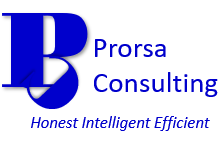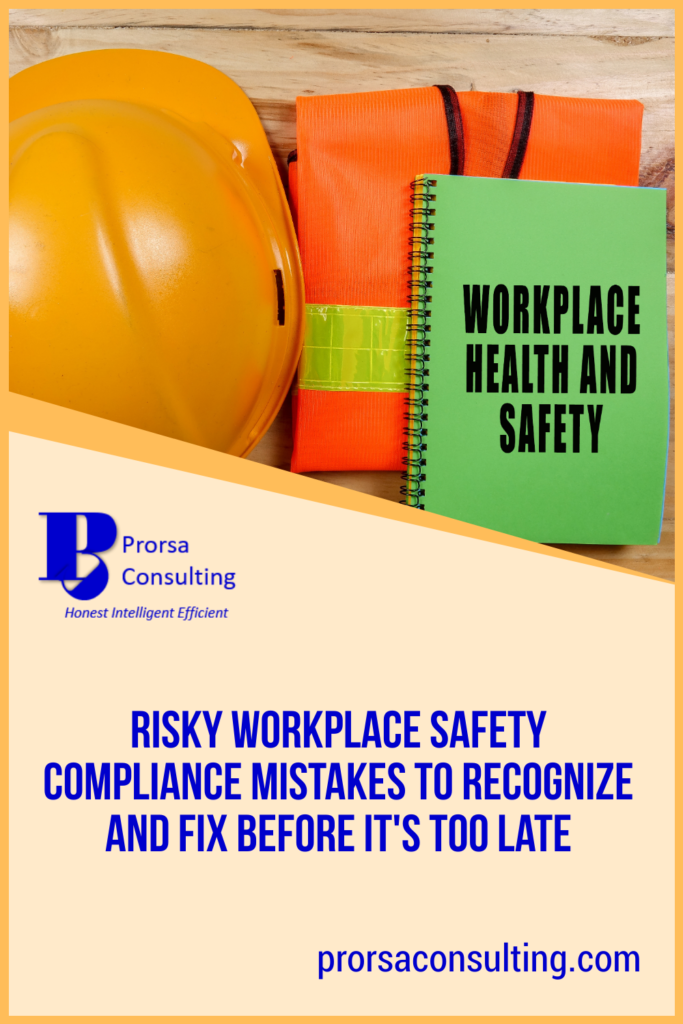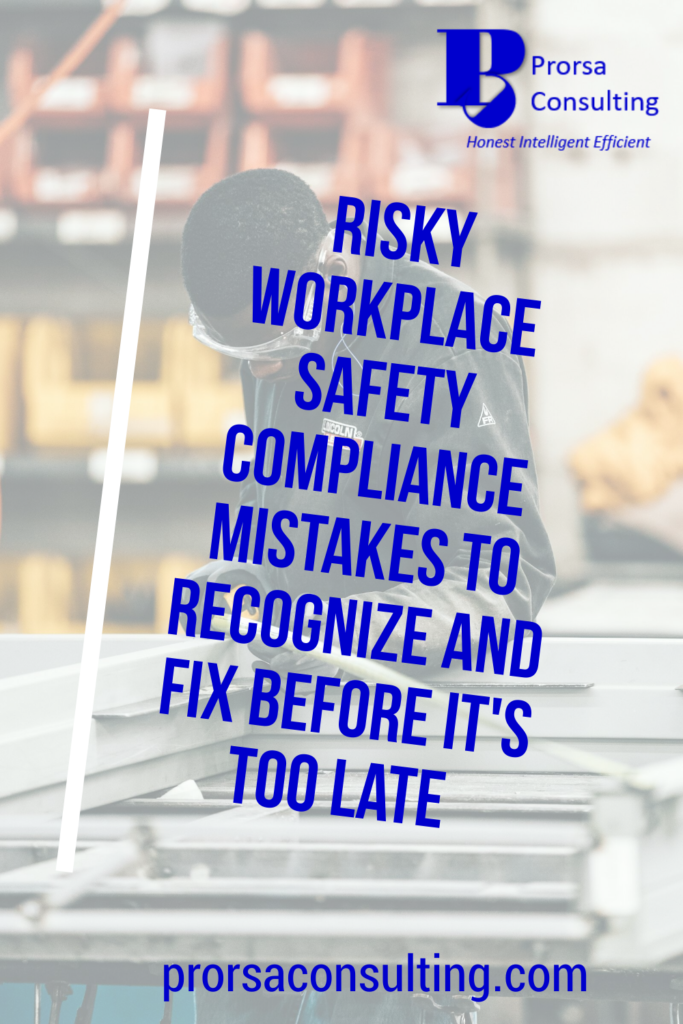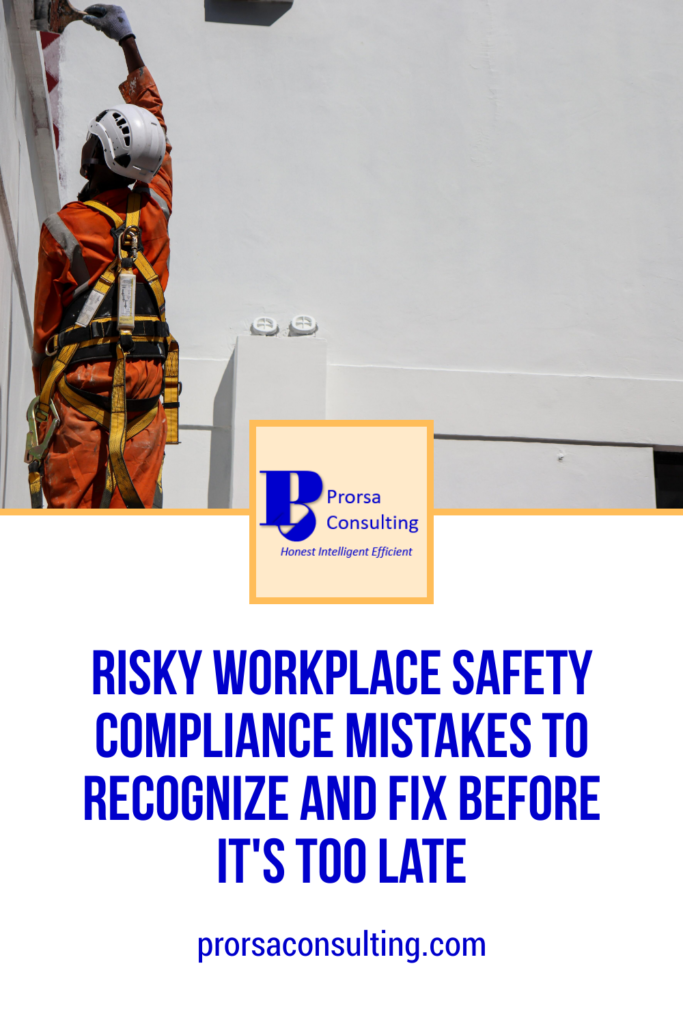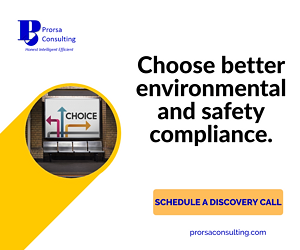Risky Workplace Safety Compliance Mistakes to Recognize and Fix Before It’s Too Late
By : Admin -
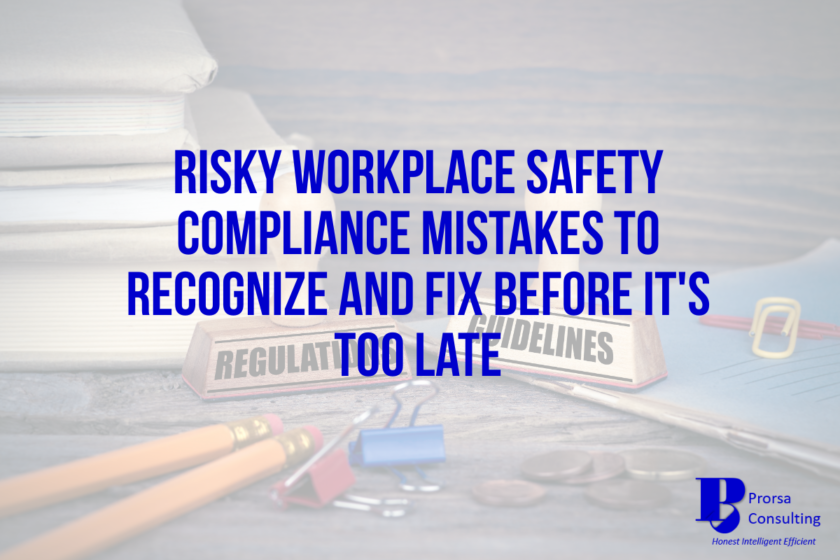
Companies create strong workplace safety compliance through dedication, solid planning, and consistent execution.
Creating a safe work environment is necessary for any organization, and that’s where a robust safety program comes into play. However, even with the best intentions, many businesses make critical mistakes that compromise workplace safety compliance and the overall effectiveness of their environmental, health, and safety (EHS) initiatives.
In this comprehensive guide, we’ll dive into the most common safety program mistakes and provide actionable insights on how to avoid them. By addressing these pitfalls, you can enhance your organization’s commitment to safety, mitigate risks, and foster a culture of well-being.
The Importance of Workplace Safety Compliance
Workplace safety compliance is paramount as it ensures employees’ well-being and fosters a positive work environment. By adhering to safety regulations and standards, organizations demonstrate their commitment to protecting their workforce from accidents, injuries, and illnesses. Compliance programs establish a framework for identifying and managing hazards, conducting risk assessments, and providing necessary training and resources. They help prevent costly legal issues, penalties, and reputational damage arising from non-compliance.
Moreover, workplace safety compliance promotes employee morale, job satisfaction, and productivity while reducing absenteeism and operational disruptions. It also enhances the organization’s brand reputation, attracting top talent and earning the trust of customers, stakeholders, and regulatory bodies. By prioritizing workplace safety compliance, businesses create a culture attentive to ensuring the overall well-being of their employees.
Mistake #1: Lack of Management Commitment and Leadership Engagement
Negative workplace safety compliance consequences of disengaged leaders
The negative safety consequences of disengaged top managers can profoundly impact the overall safety culture of an organization. When leadership is disengaged, it sends a message that safety is not a priority, leading to a lack of commitment and accountability throughout the company.
These leaders may overlook safety protocols, fail to allocate sufficient resources for safety initiatives, or neglect to provide necessary training and guidance to employees. This disengagement trickles down to the rest of the workforce, creating a culture of indifference toward safety. As a result, employees may be less inclined to follow safety procedures, leading to an increased risk of injuries, illnesses, and potential legal repercussions.
Fostering robust leadership involvement
Fostering robust leadership involvement in safety is crucial for creating a strong environmental, health, and safety culture within an organization. Establishing clear expectations and accountability for leaders regarding safety is important. Furthermore, providing regular safety training and education to leaders can enhance their understanding of safety principles and their role in promoting safe work practices.
Leaders should also lead by example, consistently demonstrating and prioritizing safety in their actions and decisions. Encouraging open communication and feedback between leaders and employees creates a supportive environment for safety discussions. Finally, involving leaders in safety committees and initiatives allows them to actively contribute to safety program development and implementation, fostering safety engagement, commitment, and organizational goal alignment.
Image by Rawpixel.com at stock.adobe.com.
Mistake #2: Inadequate Risk Assessments and Hazard Identification
What to expect when hazard recognition is not a priority
Potential dangers may go unnoticed without effective hazard recognition, increasing the likelihood of harmful events. Similarly, inadequate risk assessments can lead to underestimation of risks, thus, leaving employees exposed to hazardous conditions.
Moreover, poor hazard recognition and risk assessment undermine the effectiveness of safety measures, as appropriate controls and preventive measures cannot be implemented if hazards are not properly identified and assessed. Ultimately the overall safety culture is compromised, endangering the entire workforce.
Proper hazard identification, assessment, and control
Proper hazard identification, assessment, and control are crucial components of a robust workplace safety compliance program. Effective hazard identification involves actively searching for potential risks and hazards in the workplace, considering both physical and environmental factors. A thorough risk assessment evaluates the likelihood and severity of identified threats, allowing organizations to prioritize control measures.
Implementing control measures involves selecting and implementing appropriate strategies to eliminate or mitigate hazards, such as engineering controls, administrative processes, and personal protective equipment (PPE). By ensuring proper hazard identification, assessment, and mitigation, organizations can proactively minimize risks, create a safer work environment, and defend the health and well-being of their employees.
Mistake #3: Insufficient Workplace Safety Compliance Training and Low Employee Engagement
When workplace safety compliance training and engagement fails
Failed safety training harms the workplace. Without proper training, employees may not be equipped with the knowledge and skills to recognize and tackle potential hazards, leading to an increased risk of injuries.
Furthermore, inadequate safety engagement further compounds the issue, as disengaged workers are less likely to actively participate in safety initiatives, follow safety procedures, or report potential risks. Poor employee participation in safety hurts the organization’s overall culture, making it increasingly difficult to cultivate a safe work environment.
Promoting a strong safety culture through education and participation
Businesses must strive to provide regular, comprehensive training sessions, emphasizing how to recognize hazards, safe work practices, hazard controls, and internal safety policies. By providing worker education in a structured manner, organizations empower employees to take an active role in safety.
Engaging employees in safety initiatives, such as safety committees or toolbox talks, fosters a sense of ownership and encourages workers to participate in safety-related activities. When employees are engaged and invested in safety, they become more likely to follow safety procedures, report hazards, and contribute to continuous improvement, fostering a strong, lasting safety culture.
Mistake #4: Neglecting Proper Incident Reporting and Investigation Procedures
Why do we report and investigate
Safety incident reporting and investigation are paramount in maintaining a safe work environment. Prompt and comprehensive incident reporting allows organizations to identify and address potential risks, hazards, and near-miss events. It provides valuable data for analyzing trends, identifying root causes, and implementing effective preventive measures.
Investigations help uncover the underlying factors contributing to incidents, facilitating the development of targeted corrective actions. By encouraging a reporting and investigation culture, organizations prioritize safety and create an environment where employees feel empowered to voice safety concerns. This proactive approach prevents future incidents and improves overall safety performance, employee morale, and organizational resilience.
Encouraging reporting, investigation, and corrective action
Encouraging safety incident reporting, investigation, and associated corrective actions in a workplace safety compliance program requires an inclusive and supportive approach. It begins with fostering open communication channels, where employees feel comfortable reporting incidents without fear of reprisal. Clear guidelines and procedures for reporting and investigating incidents help streamline the process.
Likewise, promptly acknowledging reported incidents and conducting proper follow-up show employees that their concerns are taken seriously. Recognizing and rewarding individuals actively participating in notification and investigation efforts further reinforces the importance of a strong safety culture and encourages ongoing engagement.
Mistake #5: Failure to Regularly Review and Update Workplace Safety Compliance Policies and Procedures
Why keeping up to date is paramount for safe work
As new safety hazards emerge and regulations evolve, outdated policies may no longer adequately address the risks present in the workplace. Organizations also leave themselves at risk for non-compliance or out of step with industry best practices when procedural updates are neglected.
Out-of-date policies and procedures demonstrate a waning commitment to safety and the obligation to maintain a safe work environment. Furthermore, outdated documentation can lead to inefficient processes being followed, affecting overall productivity and the company’s bottom line.
How to keep safety policies and procedures relevant and effective
Effective safety policy reviews and change communication are essential for solid safety performance. Regular policy analyses involve assessing policy effectiveness, identifying gaps, and incorporating updated regulations. Clear communication channels are necessary to inform employees of policy changes, ensuring they understand their responsibilities and the reasons behind the updates.
Providing training and resources to support the implementation of new policies fosters understanding and compliance. Soliciting feedback from employees during the review process enhances engagement and allows for continuous improvement. Furthermore, transparent communication helps promote a safety-conscious workforce by engendering a shared commitment to workplace safety compliance.
Mistake #6: Inadequate Safety Communication and Awareness Programs
The results of poor communication and awareness
Choosing not to prioritize communication in a workplace safety compliance program can lead to employee confusion on a grand scale. Without clear expectations and knowledge of the program, employees may not act when necessary or take improper action at a crucial moment, leading to an undesirable outcome.
Insufficient awareness of hazards and safe work practices only invites danger. Additionally, it weakens efforts to build a robust culture of safety in the workplace and serves to hinder the organization’s ability to address safety concerns proactively.
Building a communication and awareness strategy that works
Building a solid safety communication and awareness strategy involves several key steps. Businesses should ensure that safety documentation is easily available to workers and that employees know how to access it when needed. Organizations may elect to keep such information in hardcopy or electronic format if the barriers to access are minimized.
Moreover, organizations should utilize various communication channels, such as meetings, emails, posters, and digital platforms, to consistently deliver safety messages. Encourage two-way communication, where employees can ask questions, provide feedback, and report safety concerns.
Mistake #7: Lack of Resources and Equipment Maintenance
Neglect resource allocation and equipment maintenance at your own peril
Scarce resources impede the implementation of necessary safety measures, leading to increased risks and hazards. Inadequate training, equipment, and maintenance funding compromise employee safety and well-being.
Poor equipment maintenance can result in malfunctioning or unsafe equipment, increasing the likelihood of injuries and property damage. Moreover, it can lead to decreased productivity, increased downtime, and potential regulatory non-compliance.
Structuring a path to meet resource and equipment obligations for solid workplace safety compliance
Organizations should develop a comprehensive plan to meet resource and equipment maintenance obligations for solid workplace safety compliance. The allocation of sufficient budget and resources for safety programs, training, and equipment maintenance is a must for the fruits of the business’s efforts to be realized.
Regular inspections and preventive maintenance should be scheduled to identify and deal with potential concerns before they become major problems. Facilities that establish clear roles and responsibilities for equipment maintenance and conduct regular audits to ensure accountability stand the best chance at performing well. Additionally, implementing a system for reporting and addressing equipment concerns in a timely manner contributes positively to a safe work environment and regulatory compliance.
Mistake #8: Overlooking Ergonomic Factors and Occupational Health Hazards
The need to address ergonomics and health hazards as part of an environmental, health, and safety program
Poor ergonomics can lead to musculoskeletal disorders, often resulting in pain, reduced mobility, weakness, stiffness, fatigue, and depression for the injured party. Such illnesses can cause decreased productivity and increased absenteeism for employees.
Ignoring occupational health hazards, such as exposure to harmful substances or inadequate ventilation, can result in long-term health issues. Workers with work-related health problems can suffer financial hardship, increased stress, and social isolation.
Musculoskeletal Disorders and occupational illness prevention for safe work
Being proactive is the key to addressing workplace ergonomics and occupational health hazards. Conducting thorough ergonomic and workplace evaluations helps identify potential risks and appropriate controls. Providing ergonomic training to employees promotes awareness and proper safe work practices.
Establishing effective reporting mechanisms for occupational health hazards encourages employees to report concerns promptly. Regular monitoring and correction of conditions as they occur ensure ongoing workplace safety compliance. Collaboration with occupational health professionals and implementing preventive measures also contribute to a healthy work environment for employees.
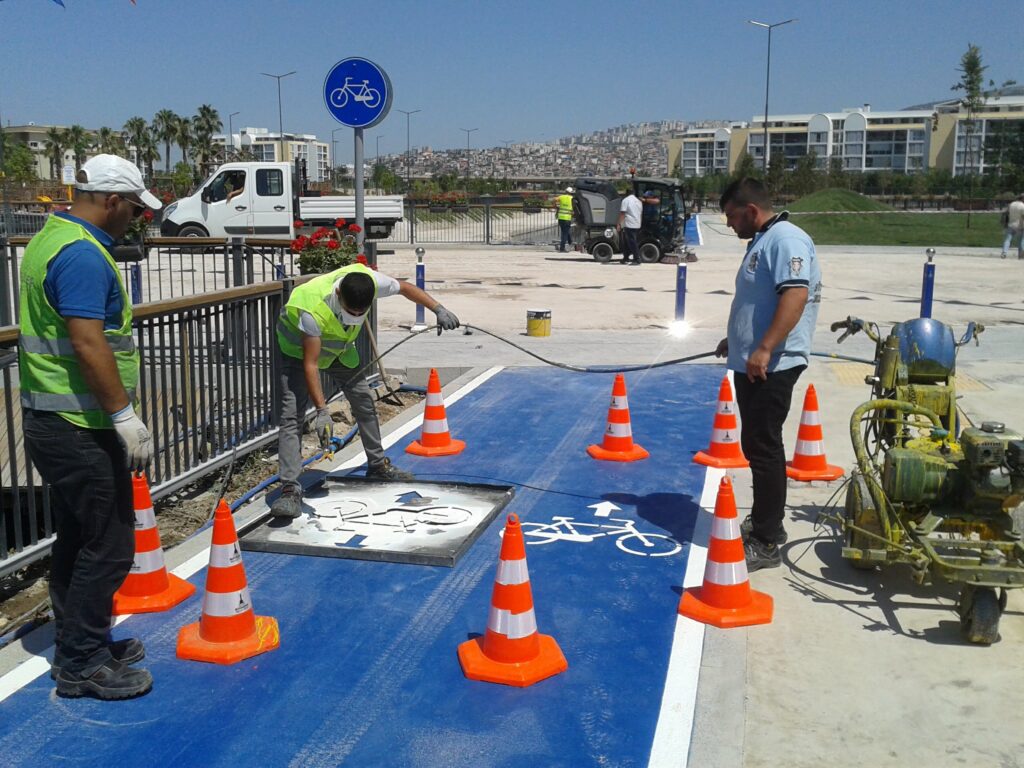
Image by Multu Barak Paskoy at pexels.com.
Mistake #9: Ignoring the Role of Contractors and Outsourced Work in Workplace Safety Compliance
Don’t forget about your business partners’ impacts on workplace safety compliance
Contractors and outsourced work can add a challenging element to safety management.
Yet, the hosting facility must ensure all workers receive equal hazard protection.
Lack of oversight and communication with contractors can result in inconsistent safety practices and an increased risk of incidents. Failure to ensure contractors meet safety standards may lead to non-compliance and legal liabilities.
Inadequate coordination and supervision can also delay the implementation of safety protocols. Effective contractor management is vital to maintain a cohesive and compliant workplace safety compliance performance at the site.
Implementing a contractors and outsourced worker management program
To effectively manage contractors and outsourced workers, organizations should implement several strategies. Firstly, establish clear safety expectations and contractual requirements, ensuring they align with company policies and industry standards. Facilities should provide comprehensive safety orientation and training as needed by the scope of work for each external worker with job duties on-site.
Moreover, regularly assess contractor performance and conduct audits to ensure compliance. Be sure to maintain open lines of communication, encouraging the reporting of safety concerns and incidents by contractors and outsourced workers. Lastly, foster collaboration and engagement between contract and in-house staff to promote a culture of safety and accountability across the workplace.
Mistake #10: Failing to Learn from Past Incidents and Implement Continuous Improvement Strategies
Paying no heed to continuous improvement
Without regular evaluation and refinement of safety processes, organizations may fail to identify and address emerging hazards and gaps in safety protocols. These lapses may result in non-compliance with evolving regulations and best practices.
Additionally, a lack of continuous improvement undermines the organization’s ability to adapt to changing work environments and technologies, lowering the overall effectiveness of the safety program. Embracing continuous improvement fosters a proactive approach to safety and ensures ongoing risk mitigation.
Enhancing your environmental, health, and safety program by analyzing experience to avoid adverse outcomes
Businesses can advance their environmental, health, and safety programs through effective incident investigations and the implementation of robust corrective and preventative measures. By analyzing incidents in detail, organizations can uncover underlying factors contributing to the event (i.e., the root cause) and implement targeted methods to address them.
This proactive approach helps prevent future similar occurrences and promotes a safer work environment. Regularly reviewing incident data and using it to drive continuous improvement ensures that safety measures are constantly updated to address emerging risks. Additionally, the lessons learned can be shared with the workforce to increase on-site safety awareness. By learning from incidents, organizations can strengthen their environmental, health, and safety programs and better protect their workers.
More Workplace Safety Compliance Posts for You
Performing a Job Hazard Analysis: Your Powerful Weapon to Prevent Workplace Injuries
Improve EHS Performance by Resolving the Poor Leadership People Never Tell You About
Never Conduct Your Safety Incident Investigation without This Timeless Roadmap
Building Solid Workplace Safety Compliance through Effective Program Management
In conclusion, workplace safety compliance is a critical aspect of organizational success. By avoiding common safety program mistakes and implementing effective strategies, businesses can create a safe work environment that prioritizes employee well-being and ensures compliance with environmental, health, and safety regulations.
Every aspect of a safety program plays a crucial role, from management engagement to thorough risk assessments, proper training, incident reporting, policy updates, communication, resource allocation, and continuous improvement. By proactively addressing the above mistakes and fostering a strong environmental, health, and safety culture, organizations can protect their workforce, enhance productivity, and build reputations as responsible and trusted employers.
We encourage your feedback on this blog. Please like, comment, and share this article if you enjoyed the content. You can also provide us with feedback via our Contact Us page.
Don’t forget to follow Prorsa Consulting on LinkedIn, Pinterest, and Twitter.
Prorsa Consulting supports regulated businesses in their efforts to assess, maintain, and improve environmental and safety compliance. Schedule a discovery call with us today If you are ready to lower the risk of costly environmental, health, and safety penalties, enhance performance, and build a more favorable business reputation.
How would you like access to additional, exclusive EHS updates & info from Prorsa Consulting? Just signup for the Prorsa Consulting Newsletter below. You’ll gain entrance to our Free Resources area and the ability to use all the library’s tools, templates, and presentations. There’s no cost, and you can cancel at any time. So, strike while the iron is hot!
Risky Workplace Safety Compliance Mistakes to Recognize and Fix Before It’s Too Late
